Top attractions:
Quick Navigation
About Dürnstein
I don’ think Dürnstein needs a lot of introduction. If the name doesn’t ring the bell, I’m sure you have seen one of those Instagram pictures with the magnificent white-and-blue tower near the river Danube. That is the bell tower of the former Dürnstein Abbey (Stift Dürnstein) of Augustinian Canons. If you haven’t seen it, may I ask you where you have been?
This magical town from a postcard has its houses pressed against the dry stones of mountains, situated at the heart of the Wachau Valley. Dürnstein is almost impossible to surpass in the terms of romance; reminiscent of a medieval town miniature which, on this small plateau between the Danube and ancient mountain crags, gently rises from the sea of green vineyards. The historic Old Town, with its narrow street and alleys, is enclosed by medieval walls, overgrown with ivy.

Isn’t this a view from a fairy tale? Photo by Alis Monte [CC BY-SA 4.0], via Connecting the Dots
God’s Finger
The famous tower, locally known as the God’s Finger, is probably the most iconic building in the whole region of the Greater Wachau, including Melk Abbey. Though the Chapel was first built in 1372, the tower of Dürnstein Abbey got its current form in the 17th century during the times, when the Baroque flourished in Austria. Hence its beauty. The gorgeousness of God’s finger is one of the two things every tourist learns very fast in Dürnstein. Another one is that it is impossible to take a good shot of the bell tower from the land. I’m not sure if it’s God’s, but the tower is sometimes definitely a finger and the certain one.
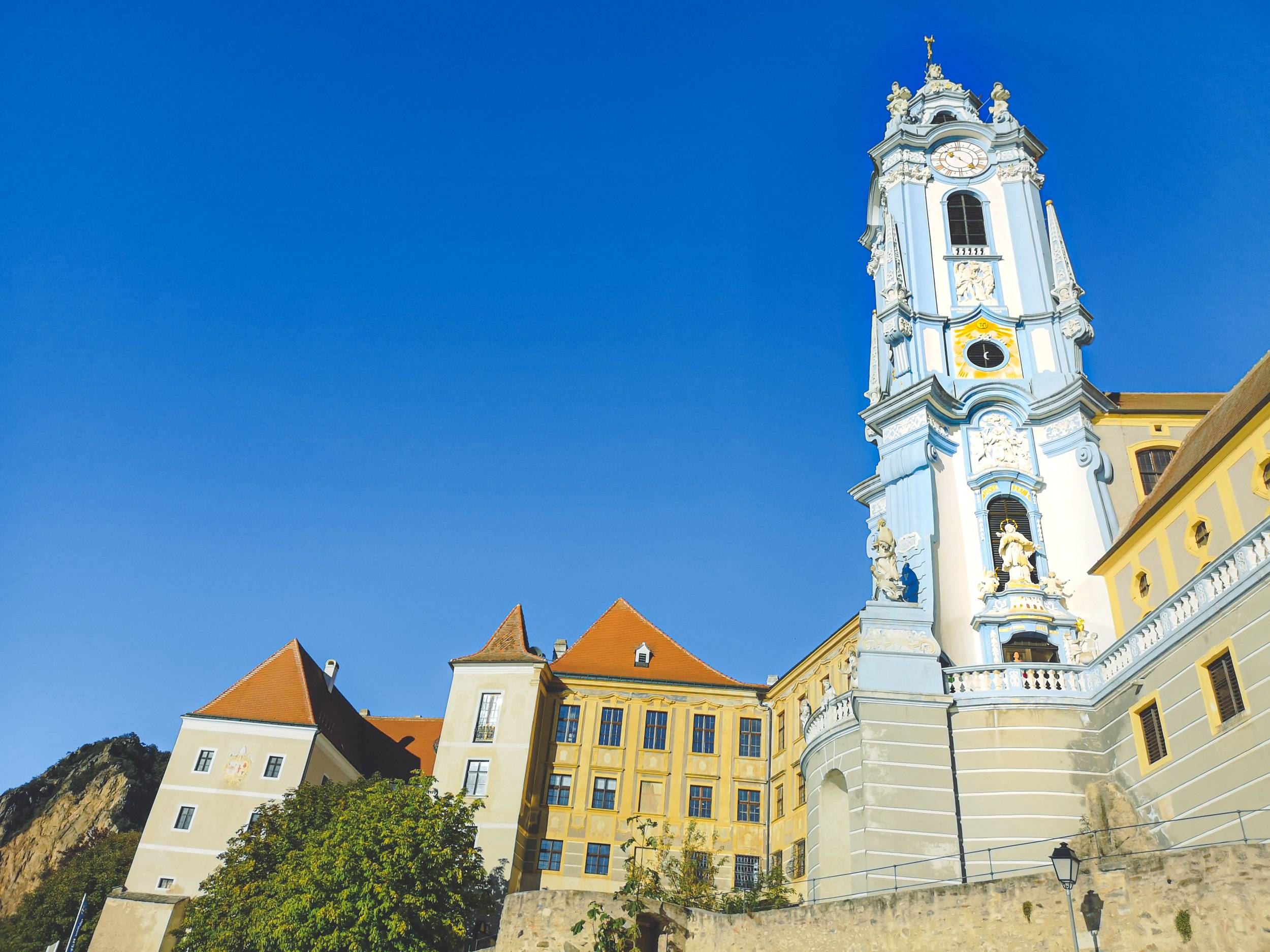
If you want to take a good shot of Dürnstein Abbey, you either have to get on cruise tour or to the other side of Danube river. Photo by Alis Monte [CC BY-SA 4.0], via Connecting the Dots
The Legendary Town
Despite being a small town of just about 900 inhabitants, Dürnstein is far from lacking people in its lively streets. The famous Tower is not the only reason for the location’s popularity. Far above the white-and-blue gem of the town stands Dürnstein castle ruins. This reminds us of the Noble Kuenringer family, who used to rule these lands.
Dürnstein was and is what would everybody imagine as a typical town of the Middle Ages. Even more, it plays a major part in one of the most important stories of that period. As you will learn, Dürnstein is the place, where the line between history and legends is very blurry.
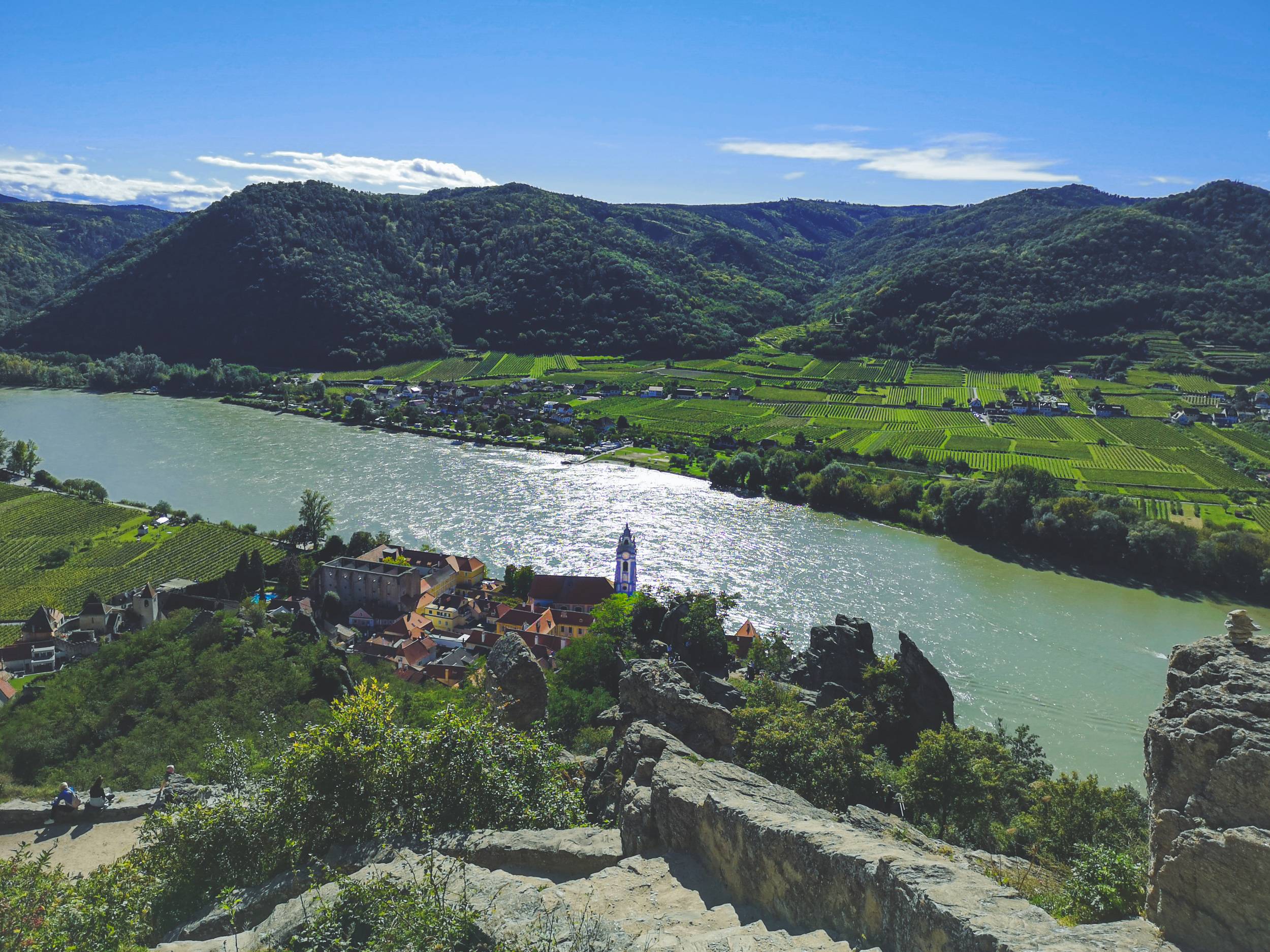
Wachau Valley is an exceptionally beautiful stretch of Danube surrounded by green mountains. Photo by Alis Monte [CC BY-SA 4.0], via Connecting the Dots
Dürnstein Details
- Location: Wachau Valley
- State: Lower Austria
- Coordinates: 48.3976° N, 15.5197° E
- Distance from Vienna: 88.5km / 55mi
- First mentioned: 1192 CE
- Population: 840 (2020)
- Area: 16.81 km² (6.49 sq mi)
- Elevation: 209m / 686ft
- UNESCO World Heritage Site: 2000
- Forecast: Dürnstein weather
- Accommodation: Booking.com
- Best time to visit: Mid-spring, Early Autumn & Early spring – the best time to see Wachau apricot blossoms
Map of Wachau Valley

The 30-minutes hike will bring you to Dürnstein Castle for absolutely amazing views. Photo by Alis Monte [CC BY-SA 4.0], via Connecting the Dots
How to get to Dürnstein
By Train & Bus
The quickest way to get to Dürnstein from Vienna by train is to get on a regional express (REX) train towards Krems an der Donau on Franz Joseph Bahnhof. In Krems get either to privately operated Wachau Bahn or WL1 VOR bus, running between Melk and Wachau. Wachau Bahn is not that cheap and it doesn’t run very often. The trailing is not covered either by Freizeit or Einfach Raus tickets.
By bus
WL1 VOR buses operate as an extension of the REX train, therefore you won’t have to wait for a long time during the change. There is no reason to use a bus between Wien and Krems an der Donau.
Pro tip: The cheapest way to get to Dürnstein from Wachau is by using the REX train and the switching to the VOR bus. The routes could be covered by Freetime (Freizeit) ticket for only 19.90€ as many times during a day as you want.

Traffic in Dürnstein is not allowed but there are plenty of parking around. Photo by Alis Monte [CC BY-SA 4.0], via Connecting the Dots
By car
To Krems: From Vienna, just follow the Danube river upstream, through roads A22, S5, S33, and then 37a.
To Dürnstein: There is a road on each side of the Danube but Dürnstein is on the left bank of the Danube, thus from Krems follow road 3.
By bicycle
Another popular way to travel within the Wachau Valley is cycling. 40km between Melk and Krems could be easily done within a day, but from Krems an der Donau to Dürnstein there is less than 1 hour of cycling. You can read more about biking through the Wachau Valley in this article.

The whole range of Wachau Valley could be cycled within a day. Photo by Alis Monte [CC BY-SA 4.0], via Connecting the Dots
Dürnstein Tours
I’ve been to Dürnstein several times and to be honest it is hard to fully appreciate the beauty of God’s Finger from the town itself. The bell tower just doesn’t fit into a shot from that close and it couldn’t be seen from around the corner. Thus, there is no better place to fully enjoy this majestic architectural masterpiece than the Danube River. There are plenty of cruise ships coming and going between Melk and Krems. Here are some of the best of them:
- From Krems: Wachau Valley River Cruise with 3-Course Meal (5h | € 47.90/person)
- From Vienna: Wachau and Danube Valleys Tour from Vienna (1day | € 79/person)
Best hotels in Dürnstein
Given the limited space, there ain’t that many hotels in Dürnstein but some of them rank among the best in the whole Austria. Wouldn’t you like to reside a castle by Danube River?
- Relais & Châteaux Hotel Schloss Dürnstein ★★★★★ – Dürnstein 2, 3601 Dürnstein, Austria
- Hotel Richard Löwenherz ★★★★ – Dürnstein 8, 3601 Dürnstein, Austria

Dürnstein has much more to offer than could be done within a day. Photo by Alis Monte [CC BY-SA 4.0], via Connecting the Dots
Dürnstein History
The history of Dürnstein starts with a bang – right where it is the most interesting. The very first written record of the town is, in fact, the one which made Dürnstein popular internationally to this day. In 1192, given the opportunity after the Third Crusade, Leopold V, the Duke of Austria, imprisoned the famous Richard the Lion Heart in Kuenringer castle, which today is known as Dürnstein Castle ruins. Yes, the same King Richard I of England from Robin Hood, and, yes, he was missing in England because he was imprisoned here, in Dürnstein. Not like most of an epic legend, the imprisonment is a historic fact.
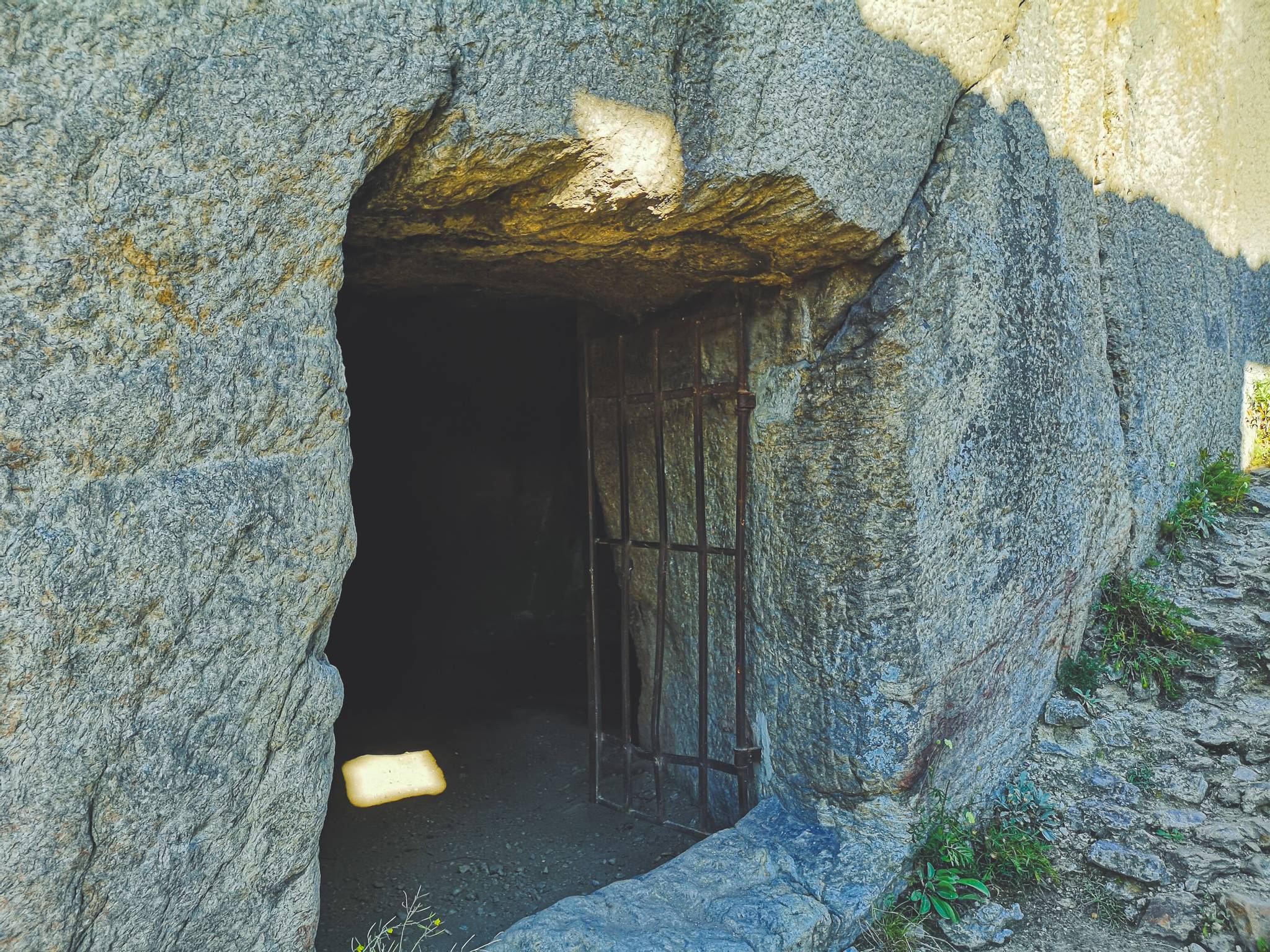
Could this room inside Dürnstein Castle could have been the one where King Richard I was imprisoned? Photo by Alis Monte [CC BY-SA 4.0], via Connecting the Dots
Legend of Robin Hood
To those who don’t know the legend, let me remind you a bit. The ballads about Robin Hood originated in 14th century and throughout the ages many different versions have been told. The two things are in common: The Sheriff of Nottingham is the nemesis of Robin Hood; Robin Hood and his gang of outlaws robbed the rich and gave to the poor. Everything happened in the absence of the rightful king, to whom Robin Hood remained loyal, while the Sheriff was on the side of a new incompetent King. There is no historical evidence that King John, the brother of Richard the Lion Heart was somehow exceptionally cruel to common people, during his rule.
The link between Robin Hood with Richard the Lion Heart is uncertain and unlikely. One is a historical person and there is no evidence that Robin Hood have existed. It is a common nickname for an outlaw during the Medieval Times in England. Some try to use the link between two figures as a proof of Robin Hood’s existence, but the older versions of the ballads have a King Edward instead. Most likely that in time two legends were connected just because it fits each other.
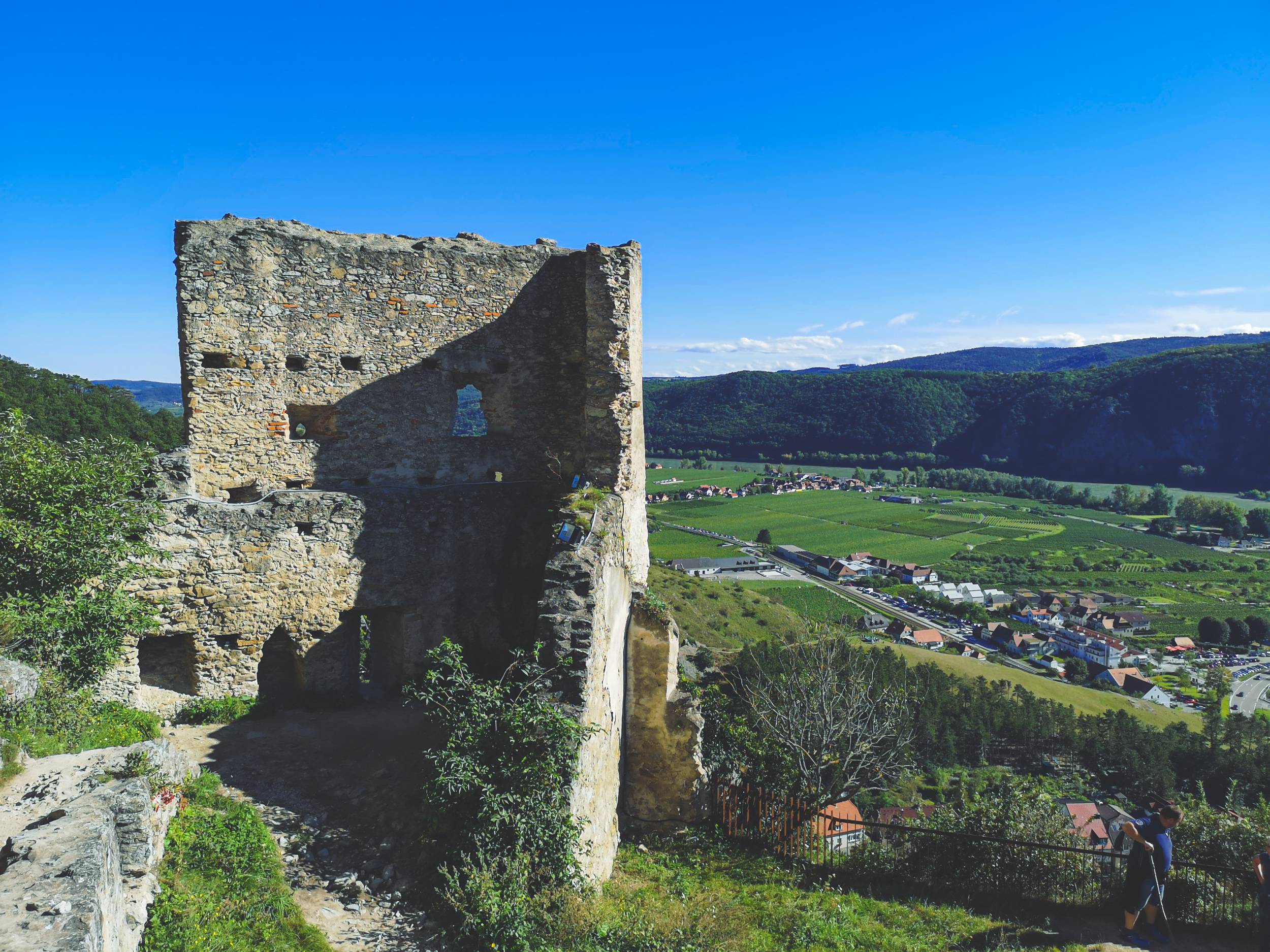
Though the story is entangled by legends, imprisonment of King Richard I in Dürnstein Castle is a historic fact. Photo by Alis Monte [CC BY-SA 4.0], via Connecting the Dots
Legend of King Richard the Lion Heart, and Blondel
Even without Robin Hood, Richard the Lion Heart is a legend on its own. When the King did not return after the Third Crusade, his loyal servant Blondel set forth to find him. He was traveling across Europe singing King Richard’s favorite song. Once he reached Dürnstein Castle, Richard sang back at him.

Dürnstein Abbey is open to visitors for a relatively low price compared to Melk Abbey. Photo by Alis Monte [CC BY-SA 4.0], via Connecting the Dots
The Rise of Dürnstein
You might think that I’m contradicting myself by stating that Dürnstein Castle is the reason the town is popular, while calling the bell tower of the abbey the most iconic place in the whole Wachau. As old as they both are, they are in fact separated by more than half of millennia; Dürnstein Abbey is an exemplary building of magnificent Austrian Baroque; Dürnstein Castle comes from the Medieval times. You see, if it was not for the imprisonment of King Richard I, I doubt Dürnstein would have seen the riches it had, ergo nobody would ever have built such a majestic church in the town but let me explain.

Dürnstein Castle can be accessed for free by anybody willing to climb the hill. Photo by Alis Monte [CC BY-SA 4.0], via Connecting the Dots
The names of landmarks and places are the true whispers from the past. In Dürnstein’s case: German “Dürr” means “dry” while “Stein” means stone. I don’t know about you, but to me, by default, drystone doesn’t sound like a name for a flourishing rich town. Dürnstein probably had emerged to support the nearby Kueringian Castle, but as time went by, the town outlasted the castle.
One way or another the point is that the location of settlement was chosen for its defensibility and not for “liveability”. Maybe, that is the reason why we have the names of other towns in the heartland of Wachau mentioned before Dürnstein. It wouldn’t surprise me if Dürnstein castle was just an outpost to defend the territory as it is located exactly, where the mountains reach the River Danube – a narrow entrance to the Wachau. Yet in this narrow space, the picturesque town has emerged.
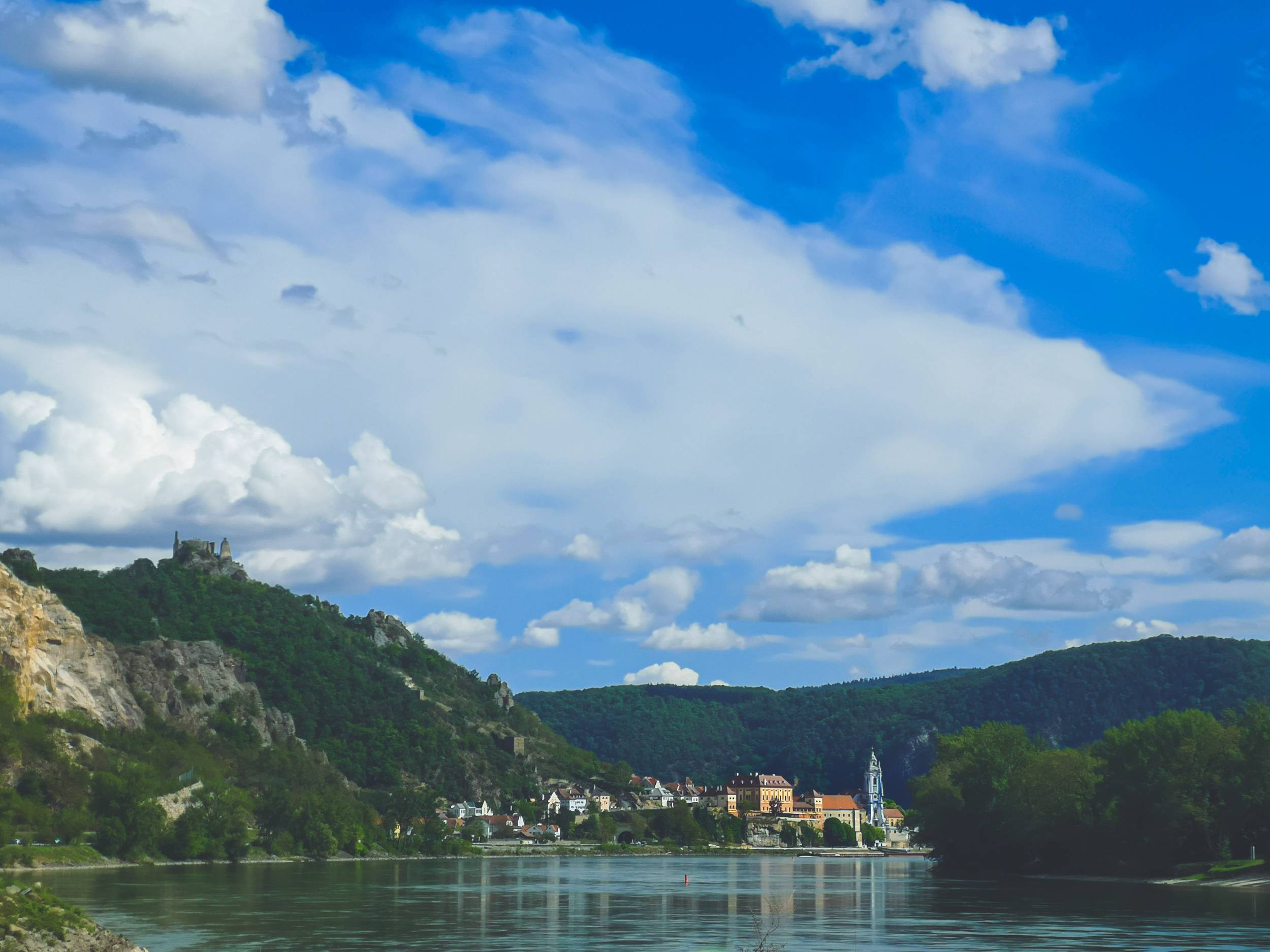
Depending on your fitness the best way to see the Wachau Valley is either by bicycle or cruise tour. Photo by Alis Monte [CC BY-SA 4.0], via Connecting the Dots
King Richard’s Ransom
Both Leopold V of Austria and Holy Roman Emperor Henry VI used their share of 100,000 silver marks very well (a good horse used to cost 3 marks in those days). The latter spent it to conquer Sicily, and the Duke of Austria founded Wiener Neustadt, fortified the towns of Friedberg, Hainburg, and Enns as well the city of Vienna. Part of the share was used to expand Dürnstein and God knows how the town would have looked like if it was not for the money.

Exploring Dürnstein is a trip of it own. Photo by Alis Monte [CC BY-SA 4.0], via Connecting the Dots
Dürnstein Castle
Dürnstein Castle itself dates about to the 11th century, when the Keunring family came to Austria and were given large territories within the state, and with time they even expanded their land, including the area around Dürnstein. It was built within the century as we already know King Richard I of England was already imprisoned in Dürnstein Castle in 1192. It withstood almost 500 years but in 1645, the Swedish troops, under General Torstenson, blew up Dürnstein Castle. It was never rebuilt again.

Dürnstein Castle was destroyed in 1645 by Swedish troops. Photo by Alis Monte [CC BY-SA 4.0], via Connecting the Dots
Leopold’s Revenge & The Third Crusade
By this time you are probably wondering, what King Richard I has done to deserve the imprisonment by Leopold V? At the beginning they were comrades, together with King Philip II Augustus of France they marched to recapture Jerusalem during the Third Crusade. We won’t go into the details of that, but in a nutshell: three biggest empires of that time joined their forces to retake Jerusalem from Muslims led by Saladin. Originally, Richard and Philip were to accompanied Holy Roman Emperor Frederick Barbarossa, but mysteriously he fell off his horse and drowned in Turkey. The deceased leader was replaced by the Duke of Austria, Leopold V.
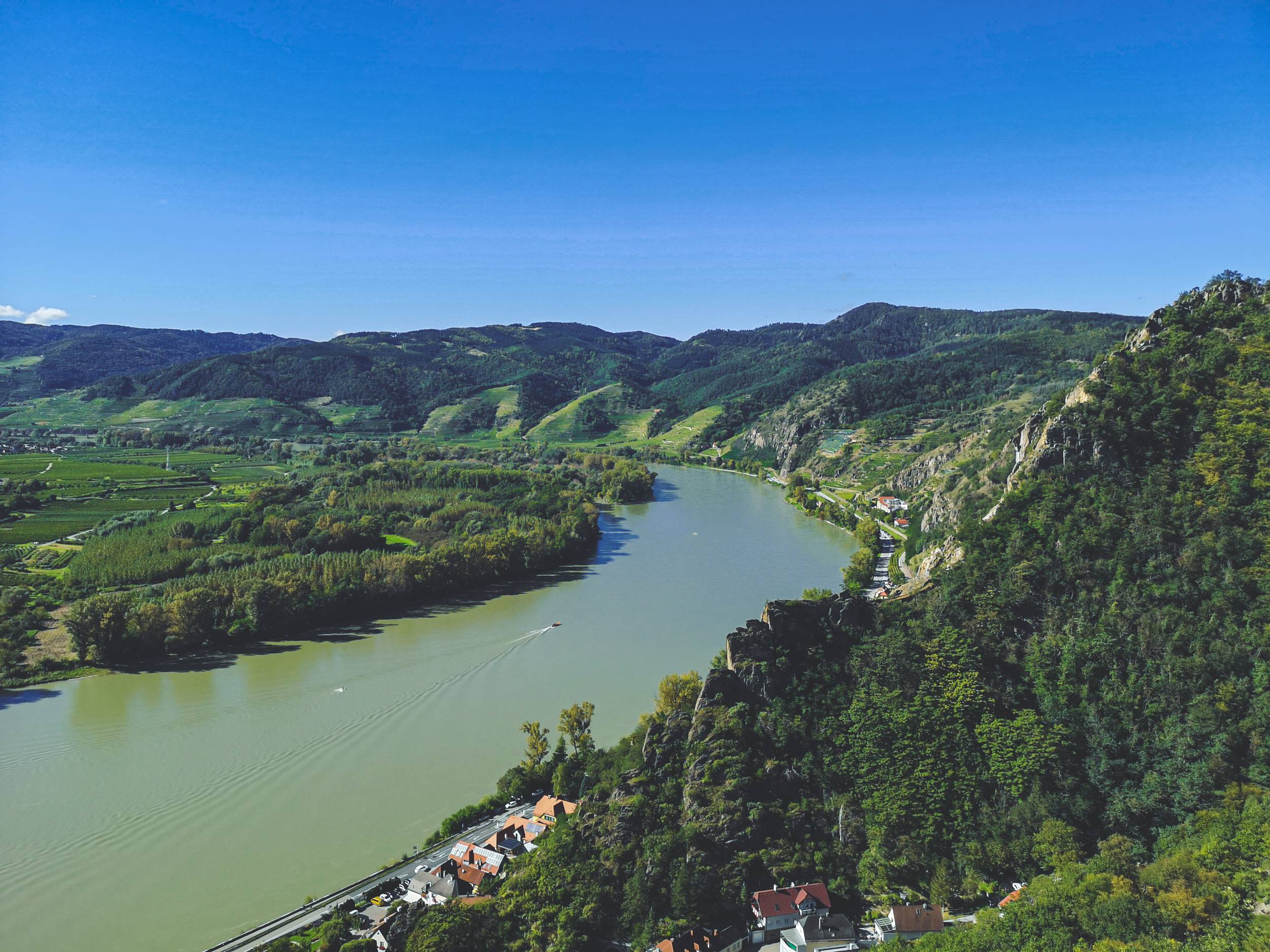
Wachau Valley is probably the most beautiful stretch of the whole Danube river. Photo by Alis Monte [CC BY-SA 4.0], via Connecting the Dots
The three successfully captured the city of Acre in the current day Israel and then argued who was to take the spoils of victory and who was the rightful heir of the Kingdom of Jerusalem. Richard the Lion Heart supported the recently released from prison King Guy, while King Philip and Leopold V backed the later’s cousin, and the defender of the remaining Christian forces in the Holy Land, Conrad of Montserrat.
During their dispute, by the orders of King Richard or not, the German banner was thrown down the wall just in front of Leopold V by the English troops. Angry with Richard, the Duke of Austria withdrew the German forces, while Philip II Augustus took the opportunity to gain more power back in Europe, and returned to his homeland together with Leopold V. The King of France left some troops and money for King Richard I to continue the Crusade. Along with some field victories, all King Richard managed to achieve was the allowance for unarmed Christian to access Jerusalem. Something they had before the First Crusade.
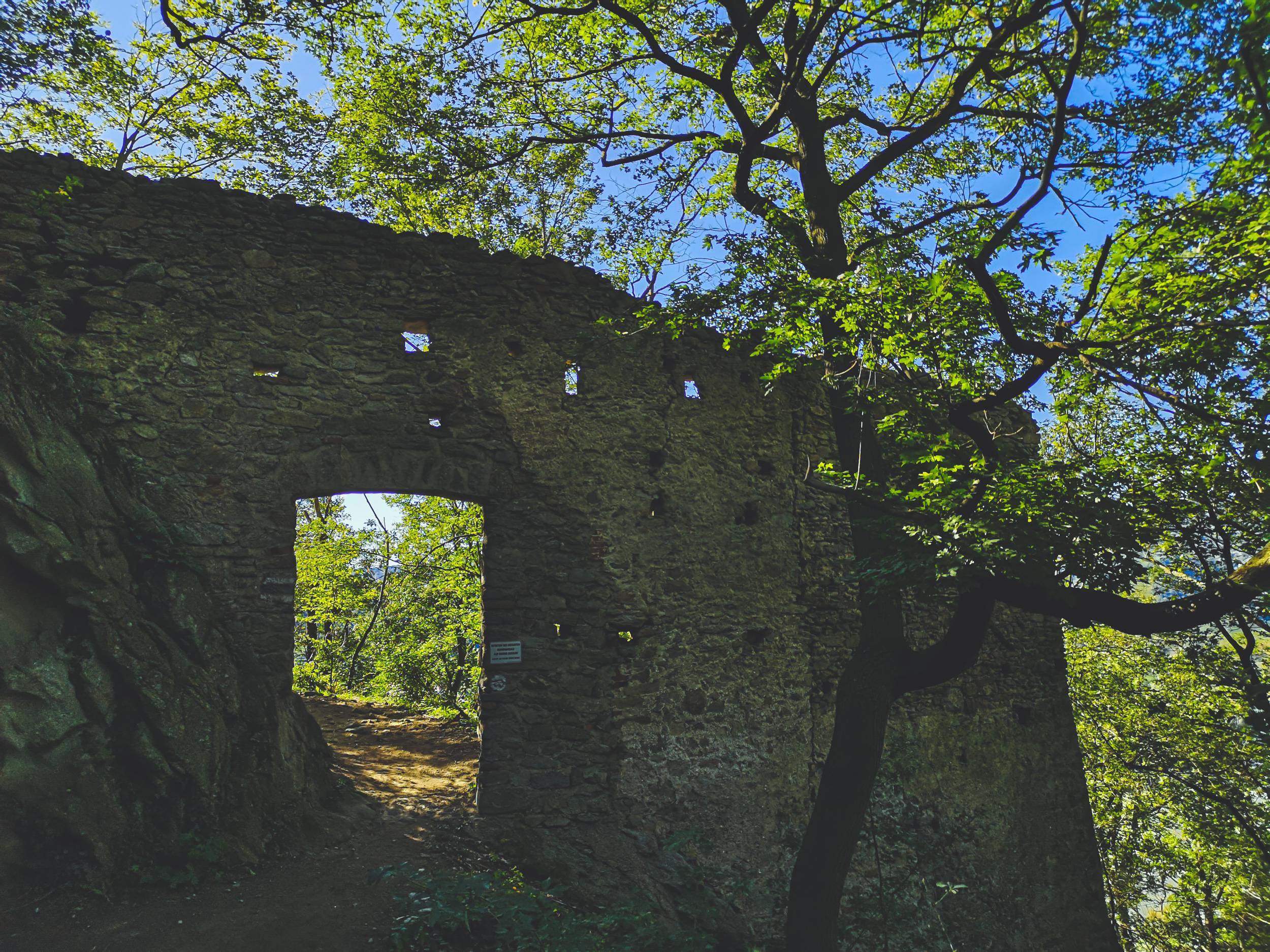
Dürnstein Castle defensive complex is entangled into the surrounding nature much deeper than it appears from the first sight. Photo by Alis Monte [CC BY-SA 4.0], via Connecting the Dots
The Aftermath & Fate of Richard the Lion Heart
Meanwhile, Leopold V learned that his cousin was assassinated in the Holy Land for which he blamed King Richard. Altogether, there were more than enough reasons for Leopold V to justify his arrest of King Richard I to Pope Celestine III and the newly emerged Holy Roman Emperor Henry VI.
While English leadership was decapitated, King Philip of France used this opportunity to increase the size of his empire at the cost of the lands, controlled by England. Later on, Richard the Lion Heart died of a wound, he got while trying to reconquer the lost territories. After everything he saw and did, King Richard got an arrow to his shoulder, which later got infected. The marksman was just a boy with a crossbow, who got his father and brothers killed fighting English armies. In revenge, he killed Richard the Lion Heart, who in return forgave the boy, saying “Live on, and by my bounty behold the light of day”.
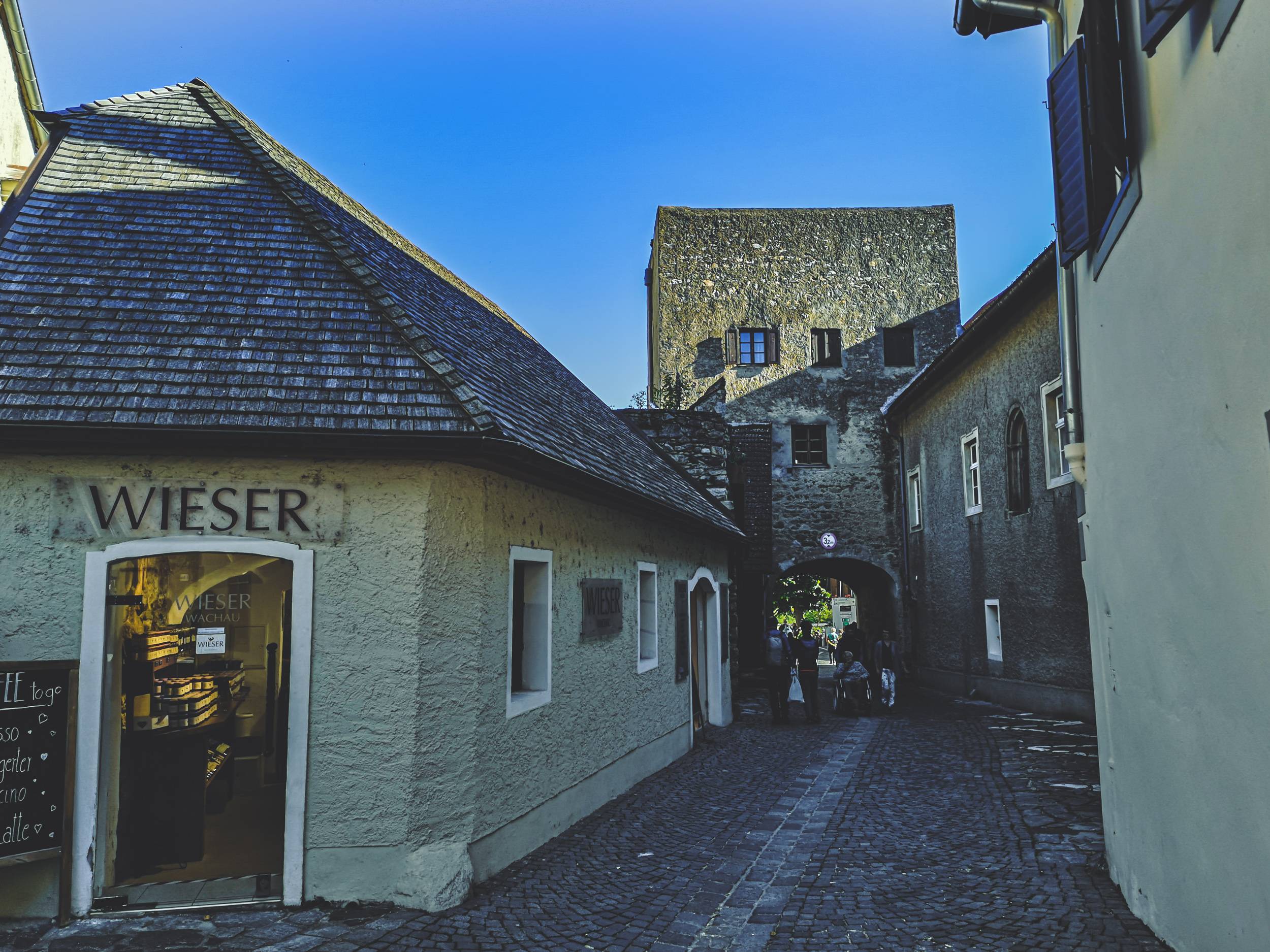
The medieval town center of Dürnstein is surrounded by an old walls. Photo by Alis Monte [CC BY-SA 4.0], via Connecting the Dots
Dürnstein Abbey
Given the already established political and historical importance, it was not that hard for Dürnstein to have Canons Regular monks to build an Abbey in 1410. Sooner or later, given the relative riches of the town, it was only natural for such a beautiful church to emerge. Like most of the most beautiful architectural masterpieces in Austria, Dürnstein Abbey’s Bell Tower got its current shape during the 17th century, when the winds of Baroque were drifting throughout the rich Christian country, motivated to show-off to its protestant neighbors. God’s Finger is one of the finest examples of that period in the whole of Austria.
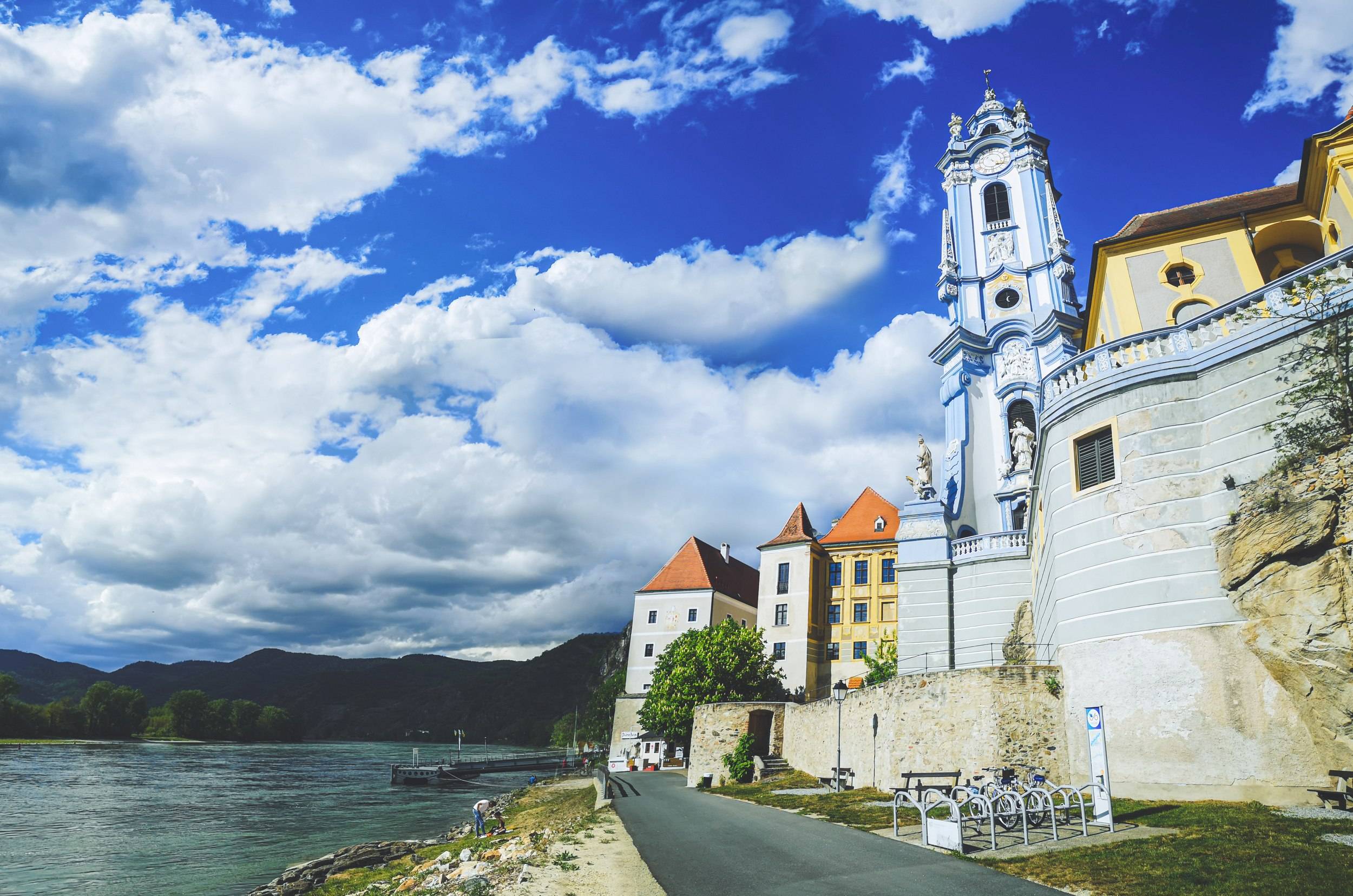
Right next to Dürnstein Abbey stands the new castle with Relais & Châteaux luxurious hotel inside. Photo by Alis Monte [CC BY-SA 4.0], via Connecting the Dots
My Impressions of Dürnstein
As much as I try to look carefully at popular tourist locations like Dürnstein, I had to admit the town is both charming and exceptionally beautiful. Dürnstein deserves everything it gets. If anybody is skeptical as I was, I’m sure that quickly, they will learn why Dürnstein is popular among foreign and even local visitors. From the legendary stories out of the Middle Ages to the white-and-blue God’s Finger, and countless hikes in the beautiful Wachau Valley, Dürnstein is a lovely surprise even to those with high expectations.

Dürnstein will leave a mark in your memory. Photo by Alis Monte [CC BY-SA 4.0], via Connecting the Dots
No man who’s jailed can this his purpose well
Adroitly, as if he could feel no pain;
But to console him, he can write a song.
I’ve many friends, but all their gifts are poor;
They’d be ashamed to know for ransom now
Two winters I’ve been failed.
My men-at-arms and barons know full well;
The English, Normans, Gascons, Poitevins,
I’ve no companion, poor though he may be,
Whom I’d abandon, leaving him in jail
And I don’t say this merely to reproach
But still, I have been jailed.– Richard Lionheart

All content and photos by Alis Monte. If you want to collaborate, contact me on info@ctdots.eu Photo by Alis Monte [CC BY-SA 4.0], via Connecting the Dots